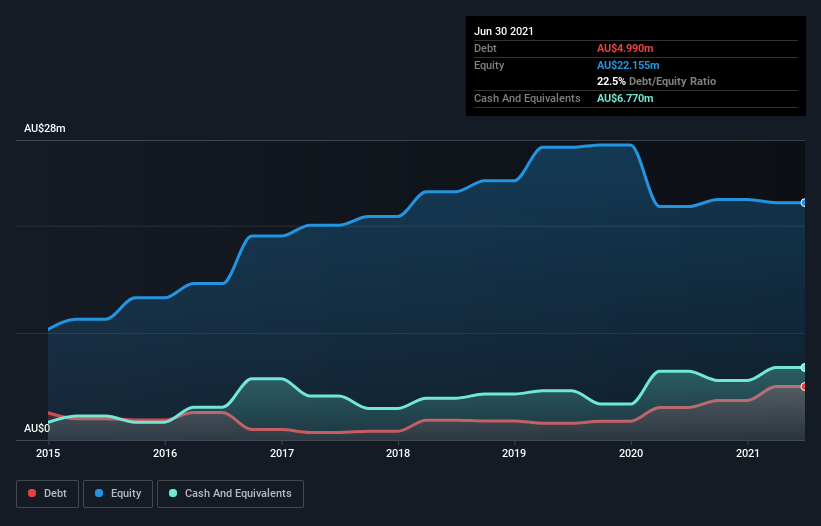Compumedics (ASX:CMP) Seems To Use Debt Quite Sensibly
Warren Buffett famously said, 'Volatility is far from synonymous with risk.' It's only natural to consider a company's balance sheet when you examine how risky it is, since debt is often involved when a business collapses. We note that Compumedics Limited (ASX:CMP) does have debt on its balance sheet. But should shareholders be worried about its use of debt?
What Risk Does Debt Bring?
Debt and other liabilities become risky for a business when it cannot easily fulfill those obligations, either with free cash flow or by raising capital at an attractive price. In the worst case scenario, a company can go bankrupt if it cannot pay its creditors. However, a more frequent (but still costly) occurrence is where a company must issue shares at bargain-basement prices, permanently diluting shareholders, just to shore up its balance sheet. Of course, the upside of debt is that it often represents cheap capital, especially when it replaces dilution in a company with the ability to reinvest at high rates of return. When we think about a company's use of debt, we first look at cash and debt together.
Check out our latest analysis for Compumedics
What Is Compumedics's Net Debt?
You can click the graphic below for the historical numbers, but it shows that as of June 2021 Compumedics had AU$4.99m of debt, an increase on AU$3.04m, over one year. But on the other hand it also has AU$6.77m in cash, leading to a AU$1.78m net cash position.
How Healthy Is Compumedics' Balance Sheet?
The latest balance sheet data shows that Compumedics had liabilities of AU$15.4m due within a year, and liabilities of AU$1.04m falling due after that. Offsetting this, it had AU$6.77m in cash and AU$15.5m in receivables that were due within 12 months. So it can boast AU$5.86m more liquid assets than total liabilities.
This short term liquidity is a sign that Compumedics could probably pay off its debt with ease, as its balance sheet is far from stretched. Succinctly put, Compumedics boasts net cash, so it's fair to say it does not have a heavy debt load!
Notably, Compumedics made a loss at the EBIT level, last year, but improved that to positive EBIT of AU$957k in the last twelve months. The balance sheet is clearly the area to focus on when you are analysing debt. But it is Compumedics's earnings that will influence how the balance sheet holds up in the future. So when considering debt, it's definitely worth looking at the earnings trend. Click here for an interactive snapshot.
But our final consideration is also important, because a company cannot pay debt with paper profits; it needs cold hard cash. Compumedics may have net cash on the balance sheet, but it is still interesting to look at how well the business converts its earnings before interest and tax (EBIT) to free cash flow, because that will influence both its need for, and its capacity to manage debt. During the last year, Compumedics burned a lot of cash. While that may be a result of expenditure for growth, it does make the debt far more risky.
Summing up
While it is always sensible to investigate a company's debt, in this case Compumedics has AU$1.78m in net cash and a decent-looking balance sheet. So we are not troubled with Compumedics's debt use. When analysing debt levels, the balance sheet is the obvious place to start. However, not all investment risk resides within the balance sheet - far from it. For instance, we've identified 4 warning signs for Compumedics (1 shouldn't be ignored) you should be aware of.
If you're interested in investing in businesses that can grow profits without the burden of debt, then check out this free list of growing businesses that have net cash on the balance sheet.
This article by Simply Wall St is general in nature. We provide commentary based on historical data and analyst forecasts only using an unbiased methodology and our articles are not intended to be financial advice. It does not constitute a recommendation to buy or sell any stock, and does not take account of your objectives, or your financial situation. We aim to bring you long-term focused analysis driven by fundamental data. Note that our analysis may not factor in the latest price-sensitive company announcements or qualitative material. Simply Wall St has no position in any stocks mentioned.
Have feedback on this article? Concerned about the content? Get in touch with us directly. Alternatively, email editorial-team (at) simplywallst.com.

 Yahoo Finance
Yahoo Finance 
